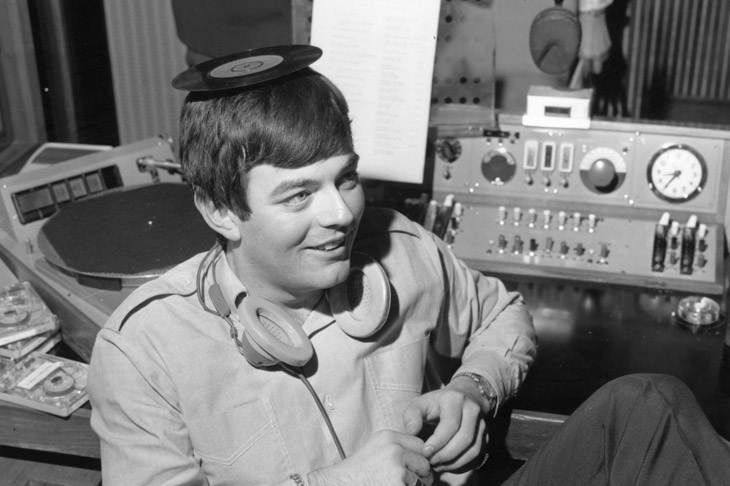Think back to that morning in September 1967 when the Light Programme was split in two, Tony Blackburn launching Radio 1 with a jaunty new jingle announcing it was all ‘Just for Fun’ while staid old Radio 2 went on with the Breakfast Show and told its listeners to ‘Wake Up Easy’. What is so surprising is just how radical the changes at the BBC were. On that unsuspecting morning, as the Pope urged for peace in Vietnam and a cannabis farm was discovered in Bristol, the Beeb’s radio output was completely overhauled.
It was not just that a new station was launched, addressing the problems posed to the BBC’s listener profile by the lurid temptations of the pirates — those radio stations anchored offshore and unbound by the protocols on which Auntie was run. Much more drastically, the Light Programme, Third Programme and Home Service were all done away with and replaced by networks known only by number. How on earth could listeners identify with something called merely 1 or 2, let alone 3 and 4?
No wonder the powers that be were anxious. Early-morning listeners on 1500 metre Long Wave would have heard the controller warning them in advance: ‘We can only hope they [the new stations] will find acceptance.’ No rehearsals had been possible, so ‘like a new pair of shoes we shall be breaking the networks in until they fit properly. We must crave your indulgence if the shoes squeak a bit.’
Last weekend’s pop-up vintage Radio 1 station (only available in digital format), taking us back to those heady days of Fluff, Emperor Rosko and the inimitable Kenny Everett, was a trip too far down memory lane for some of us. While younger listeners must have been bewildered by some of the accents (so ultra RP), the cheesy jingles and the overwhelming maleness of it all, to me it was too much of a blast from a very long-distant past to feel comfortable. The music was good, though.
Saturday-night’s Between the Ears feature on Radio 3 was an atmospheric adventure in 3-D sound, taking us up a mountainside in the company of the poet Helen Mort and veteran climber Gwen Moffat, with every footfall etched on air. Give Me Space Below My Feet (produced by Clare Walker) was inspired by Moffat, who took up climbing during the war after picking up a hitchhiking conscientious objector (and climber) while driving her army van. She fell in love, deserted from the army, and lived in the wild instead. On my first two climbs, she said, ‘the rocks were alive. I was pulling myself up, using my body. I think I found something… I found myself.’
As Mort pulled herself up the rockface above the Langdale valley in the Lake District, we heard Moffat looking back on her life in the mountains. ‘They are more part of me than anything else… I think of them more as home than I do a stone structure.’ Often, she would climb in a bikini, coming back down covered with scratches, ‘as if I’d been whipped’. Now 93, she can only dream about rockfaces, and the rasping sound of rope across granite, but until she was 90 she was still out there on the hills. ‘It’s so dull, life, otherwise.’
Stuff — those piles of unread books, useless ornaments, out-of-date papers that clutter up our lives but prove so difficult to dispose of — was the subject of The Essay this week on Radio 3 (produced by Arlene Gregorius). Joanna Robertson wonders not so much why it can be so wrenchingly difficult to throw any of it away, or whether the Japanese ‘clean-living’ guru Marie Kondo has a point, or not. Her quest is simply to achieve that state, as advised by William Morris, ‘to have nothing in your house that you do not know to be useful or believe to be beautiful’. But how do you determine what’s useful, beyond the kitchen knife, kettle and bar of soap? Does something that has emotional connection but no function or beauty have to be consigned to the recycling bin?
Along the way we are reminded how a seemingly casual postcard, an ancient reproduction of a Matisse painting, unearthed from a hidden drawer, can conjure up memories of the delicious Sunday lunches Robertson had as a child in the dining-room where a large-scale print of that same Matisse hung. Or the emotional resonance of a mere bottle, as captured by the Italian artist Giorgio Morandi. Stuff does matter.
Robertson was prompted to embark on her sifting project by the arrival at her small apartment in Paris of belongings from her mother’s house. All the wrong things had been sent across the Channel, none of which she really wanted, but all of which remind her, painfully, that her mother has gone for ever. In the end, she says, we have to accept that from what remains, although random, unplanned, unrepresentative, will emerge ‘the evidence shaping family stories’. A tin box contains the obituary of a long-dead but recognised relative, war medals and a sepia photograph. There are books with handwritten dedications and bookplates. Her words resonated powerfully, having just gone through the process myself. Anyone know how to dispose of a fur coat?






Comments